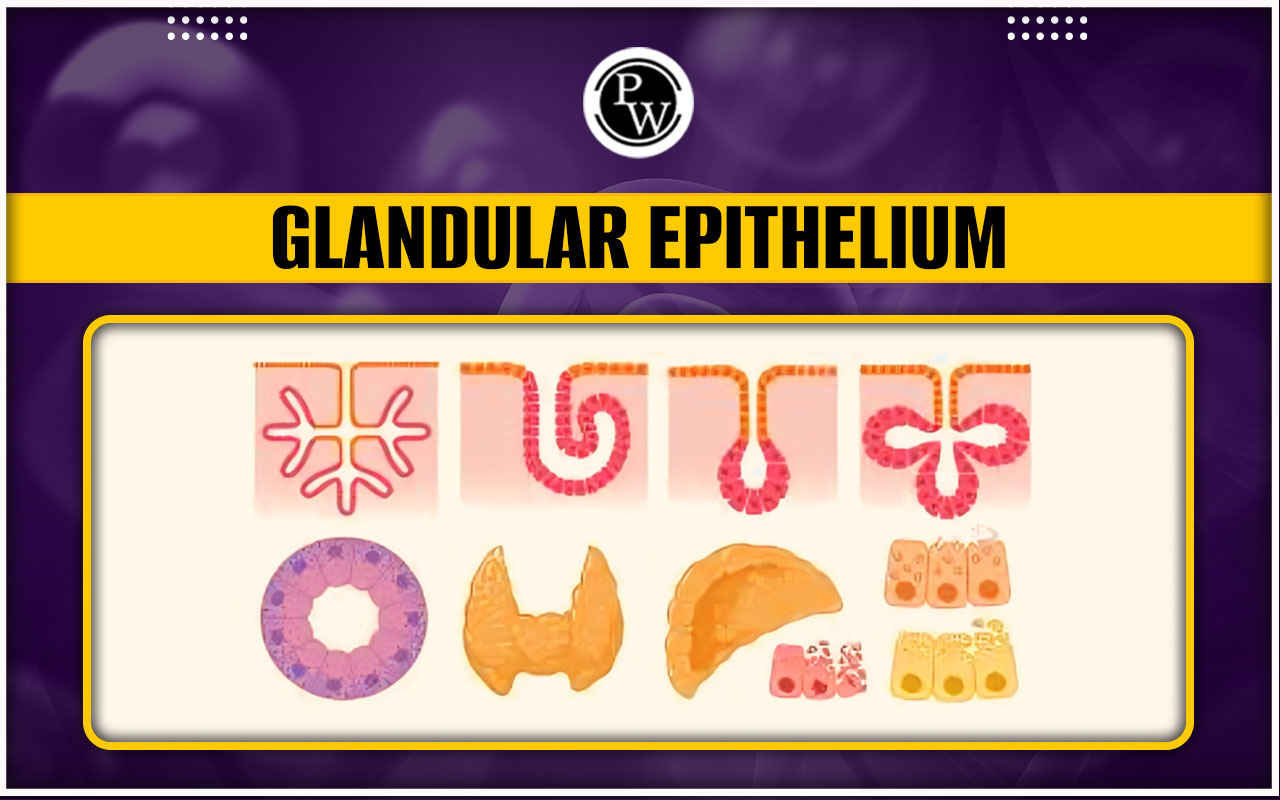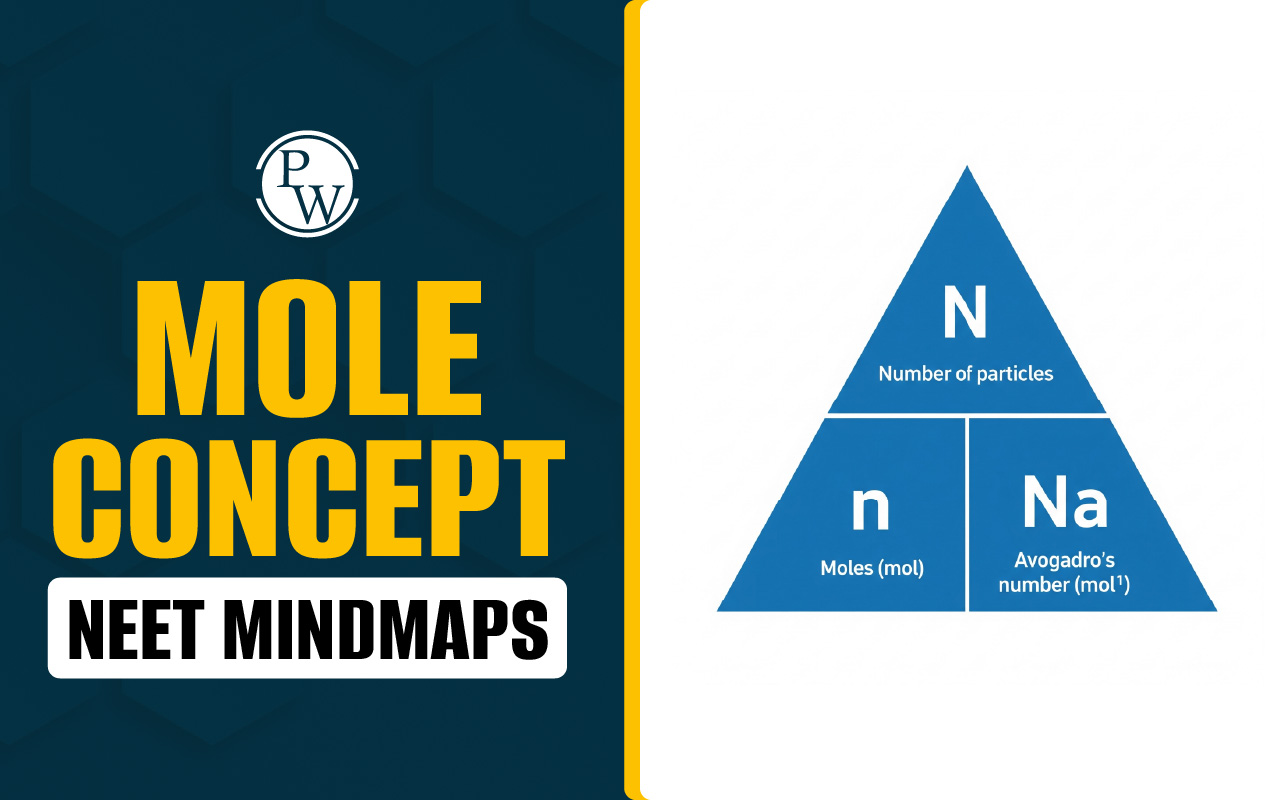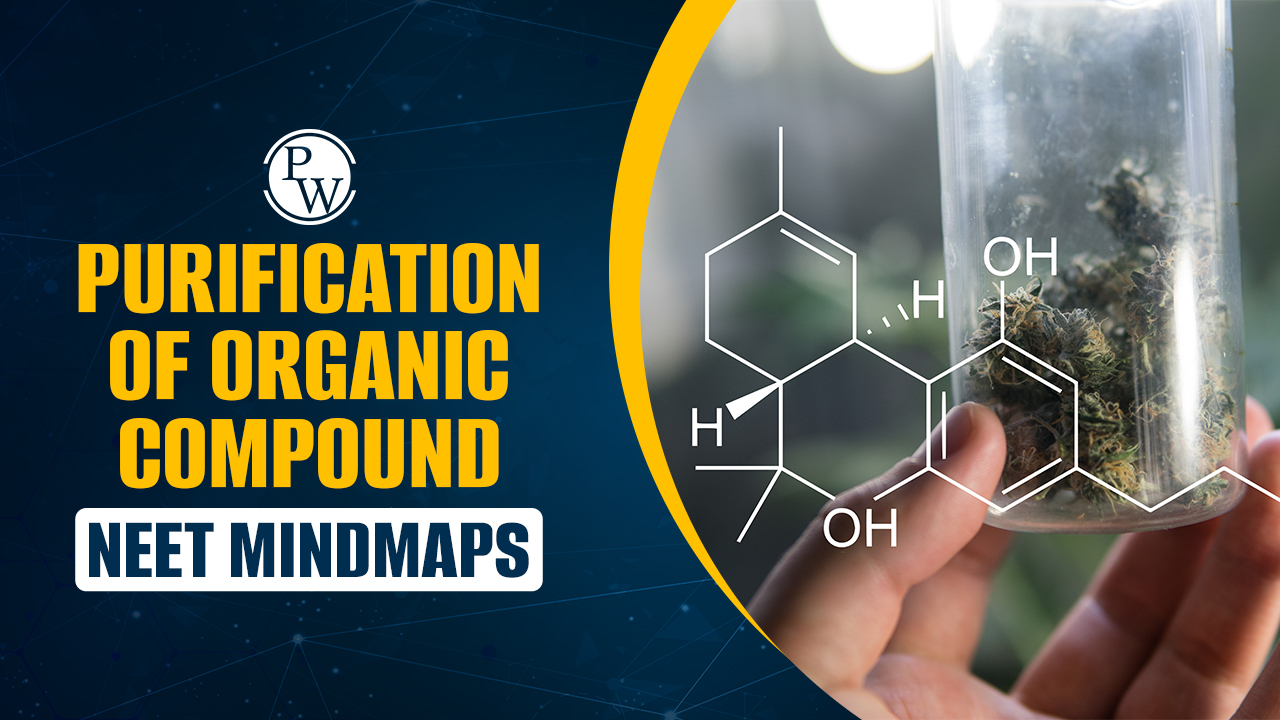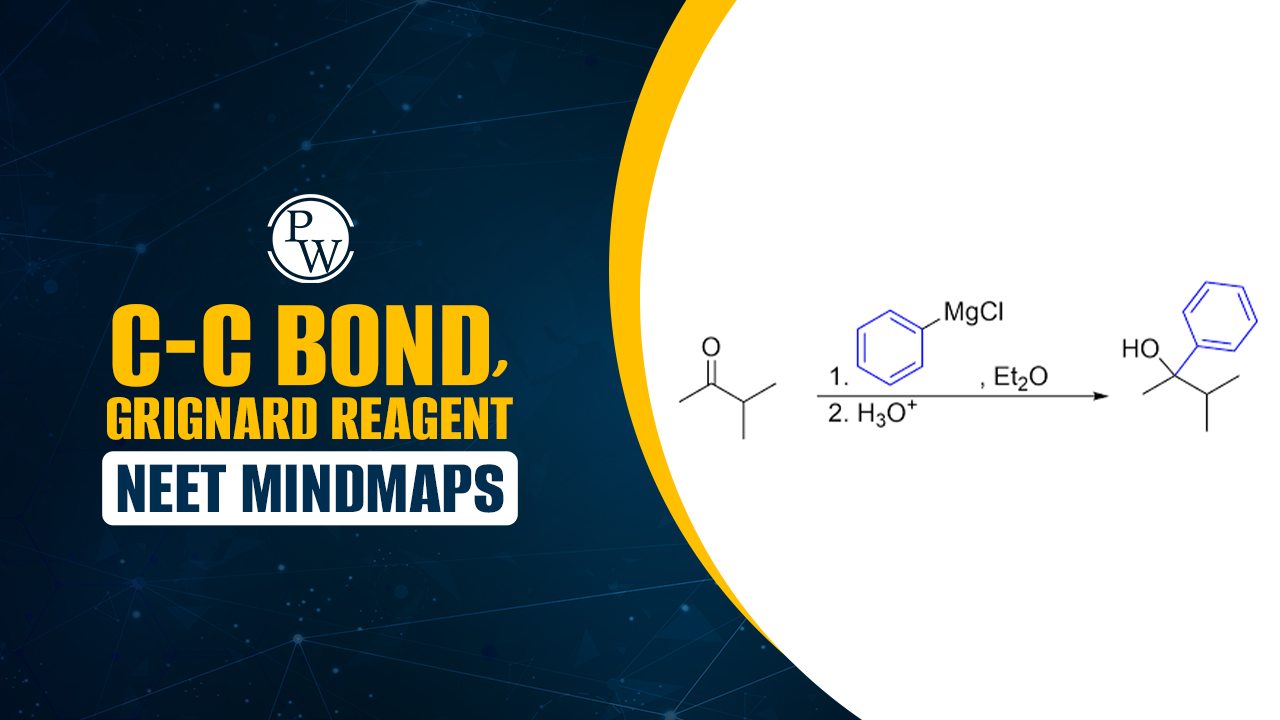

Glandular Epithelium: Epithelium is one of the four major types of tissue found in the human body, along with muscle tissue, connective tissue, and nervous tissue. Epithelial tissues consist of one or more layers of epithelial cells, separated from the underlying connective tissue by the basement membrane, a thin layer of collagen that provides structural support. The epithelium protects the majority of the body's internal and external surfaces, including the skin, digestive system, urogenital system, and respiratory tracts.
Based on its primary function, epithelial tissue can be divided into two types: non-secretory surface epithelium (such as stratified epithelium), which acts as a protective barrier against external and internal threats, and secretory glandular epithelium. Detailed NEET biology notes on glandular epithelium are provided in the article below.Glandular Epithelium Definition
Glandular epithelium, also called glandular tissue, is a type of epithelial tissue responsible for producing and releasing various secretions, including sweat, saliva, breast milk, digestive enzymes, and hormones, among other substances. This tissue forms structures known as glands, which can consist of either a single cell or a group of specialized cells that produce and release specific substances. These glands perform vital functions in the human body by releasing their secretions.Glandular Epithelium Location
The glandular epithelium is located in various parts of the body and comes in two forms:1. Single secretory cells: For instance, goblet cells found in the digestive and respiratory tracts.
2. Grouped secretory cells: These form larger glands, such as:
- Salivary glands (parotid, submandibular, sublingual) that produce saliva and digestive enzymes.
- Sweat glands located on the skin.
- Lacrimal glands in the eyes that produce tears.
3. Endocrine glands release their secretions (hormones) directly into the bloodstream, where they travel to target organs throughout the body.
Sexual Reproduction in Flowering Plants
Glandular Epithelium Types
Glandular epithelium, also known as glandular tissue, is a specialized form of epithelial tissue whose primary role is to produce and secrete various substances, such as hormones, enzymes, sweat, and mucus. These secretions are essential for numerous bodily functions. Glandular epithelium forms structures called glands, which can be either unicellular (single cell) or multicellular (groups of cells). The glandular epithelium is categorized into two main types based on how they release their secretions:Exocrine Glands
These glands have ducts that transport their secretions to the surface of the epithelium or the lumen of an organ. Examples of exocrine glands include:- Salivary Glands: Secrete saliva and digestive enzymes.
- Sweat Glands: Found in the skin, they produce sweat.
- Lacrimal Glands : Responsible for producing tears.
- Mammary Glands and Sebaceous Glands also fall under this category.
| NEET Biology Notes | |||
|---|---|---|---|
| Embryo | Funaria | Selaginella | Malvaceae |
| Polyembryony | Apomixis | Pinus | Pollen Grains |
| Chara | Volvox | Endosperm | Equisetum |
Endocrine Glands
Unlike exocrine glands, endocrine glands do not have ducts and release their secretions directly into the bloodstream. These secretions, known as hormones, travel through the bloodstream and regulate various physiological processes throughout the body. Examples of endocrine glands include:- Thyroid Gland: Regulates metabolism, growth, and development.
- Pituitary Gland: Controls various other endocrine glands and various bodily functions.
- Adrenal Glands: Produce hormones that help regulate metabolism, immune response, and stress.
Glandular Epithelium Structure
Glandular epithelium is a type of epithelial tissue that produces and secretes hormones, enzymes, and mucus. This tissue is found in various glands throughout the body, including endocrine glands, which release hormones directly into the bloodstream, and exocrine glands, which release substances through ducts to an epithelial surface. These are the main functional cells of glandular epithelium, responsible for producing and releasing substances. Their shape and size vary depending on the gland's function and the type of substance produced. Their shape typically categorizes them:- Cuboidal Cells: These are cube-shaped with a central nucleus and are commonly found in glands like the thyroid.
- Columnar Cells: These are tall and column-like with nuclei near the base, often found in glands that secrete mucus, such as goblet cells in the intestines.
- Pyramidal Cells: These pyramid-shaped cells are found in glands like the pancreas.
| NEET Biology Notes | ||
|---|---|---|
| Plasma Membrane Structure | Pre-Fertilisation | Economic Importance of Algae |
| Slime moulds | hypotonic solution | Post fertilisation |
How is Glandular Epithelium Formed?
Glandular epithelium, or glandular tissue, is essential for producing and releasing various secretions, including sweat, saliva, breast milk, digestive enzymes, and hormones. Glandular epithelium formation is as follows: Formation During Fetal Development:- Glandular epithelium originates during fetal development when epithelial cells extend into the underlying connective tissue.
- Initially, all glands are linked to the surface epithelium through a duct.
- As development continues, glands differentiate into either exocrine or endocrine glands depending on the presence of ducts:
- Exocrine glands have both a secretory portion and a duct. They release their products (such as sweat and digestive enzymes) onto an epithelial surface (like the skin or digestive tract).
- Endocrine glands do not have ducts. They release their products (hormones) directly into nearby blood vessels, which then distribute them throughout the body.
| NEET Biology Notes | |||
|---|---|---|---|
| Rhizopus | Fibrous root | Marchantia | Actinomycetes |
| Nostoc | Spirogyra | Ribosomes | Liverworts |
Glandular Epithelium Functions
Glandular epithelium is a type of epithelial tissue that is specialized for producing and secreting various substances. It forms the functional components of glands and can be classified based on the type of secretion, method of secretion, and gland structure. The primary functions of glandular epithelium include:1. Secretion
The primary role of glandular epithelium is to produce and release a variety of substances, including:- Enzymes: Produced by digestive glands such as the salivary glands and pancreas, aiding in digestion.
- Hormones: Secreted by endocrine glands like the thyroid and adrenal glands, regulating various body functions.
- Mucus: Produced by goblet cells and mucous glands to lubricate and protect surfaces.
- Sweat: Produced by sweat glands to help regulate body temperature and excrete waste.
- Milk: Produced by mammary glands to nourish offspring.
- Sebum: Produced by sebaceous glands to lubricate and protect the skin.
2. Absorption
Some glandular epithelia, especially those in the digestive system, absorb nutrients in addition to secreting digestive enzymes. For example, the lining of the small intestine absorbs nutrients while secreting enzymes for digestion.3. Protection
Glandular epithelium also serves a protective role. Mucous glands secrete mucus, trapping pathogens and particles, thereby protecting underlying tissues from damage and infection.4. Excretion
Glandular epithelium helps in excreting waste products. For instance, sweat glands excrete urea, salts, and other metabolic wastes through sweat.5. Lubrication
Many glandular epithelia secrete substances that lubricate body surfaces, reducing friction and allowing smooth movement of tissues. For example, synovial glands secrete synovial fluid to lubricate joints.Glandular Epithelium Examples
Glandular epithelium, also known as glandular tissue, is essential for producing and releasing various substances. The following are some examples of glandular epithelium:Endocrine Glands:
- Pituitary Gland: Located at the base of the brain, it releases hormones that regulate various bodily functions.
- Pineal Gland: Found in the brain, it produces melatonin, which influences sleepwake cycles.
- Thyroid and Parathyroid Glands: Located near the larynx, they secrete hormones involved in metabolism and calcium regulation.
- Adrenal Glands: Situated above the kidneys, they release hormones like cortisol and adrenaline.
- Pancreas: Located near the stomach, it produces digestive enzymes and insulin.
- Ovaries and Testes: These reproductive glands release sex hormones.
- Thymus: Found in the thoracic cavity, it plays a role in immune function.
- Salivary Glands: These glands (e.g., parotid, submandibular, sublingual) secrete saliva and digestive enzymes.
- Sweat Glands: Located on the skin, they produce sweat.
- Lacrimal Glands: Responsible for tear secretion.
| NEET Exam Important Links | |
|---|---|
| NEET Syllabus | NEET Biology Diagrams |
| NEET Biology MCQ | NEET Biology Chapter wise Weightage |
| NEET Biology Notes | NEET Previous Year Question papers |
Glandular Epithelium FAQs
Q 1. Where is glandular epithelium found?
Ans. Glandular epithelium is found in the secretory parts of glands, such as sweat glands on the skin and endocrine glands throughout the body. The human body has various glands that release substances important for bodily functions.
Q 2. What is the function and location of glandular epithelium?
Ans. The covering and lining of the epithelium forms the outer layer of the skin (epidermis) and lines the inner cavities of the cardiovascular, digestive, and respiratory systems. It also covers the walls of organs in the ventral body cavity. Glandular epithelium forms the glands of the body.
Q 3. What is epithelium?
Ans. Epithelium is a type of tissue that covers all internal and external surfaces of the body, lines body cavities and hollow organs, and is the primary tissue in glands.
Q 4. Which cells are called glandular epithelium?
Ans. Glandular epithelial cells are cuboidal cells. Some of these cuboidal cells are modified for secretion and are known as glandular epithelium. Glandular epithelium is categorized into two types: unicellular (e.g., goblet cells) and multicellular (e.g., salivary glands).
Q 5. Where is exocrine glandular epithelium located?
Ans. An example of unicellular exocrine glandular epithelium is the goblet cell, found in the lining of the small and large intestines and in the respiratory tract.
Q 6. What is an example of a glandular cell?
Ans. Glandular epithelial cells form various glands in the body. Examples include the sebaceous glands of the skin, glands in the intestinal lining (exocrine glands), and many endocrine glands that release hormones, such as those found
🔥 Trending Blogs
Talk to a counsellorHave doubts? Our support team will be happy to assist you!

Check out these Related Articles
Free Learning Resources
PW Books
Notes (Class 10-12)
PW Study Materials
Notes (Class 6-9)
Ncert Solutions
Govt Exams
Class 6th to 12th Online Courses
Govt Job Exams Courses
UPSC Coaching
Defence Exam Coaching
Gate Exam Coaching
Other Exams
Know about Physics Wallah
Physics Wallah is an Indian edtech platform that provides accessible & comprehensive learning experiences to students from Class 6th to postgraduate level. We also provide extensive NCERT solutions, sample paper, NEET, JEE Mains, BITSAT previous year papers & more such resources to students. Physics Wallah also caters to over 3.5 million registered students and over 78 lakh+ Youtube subscribers with 4.8 rating on its app.
We Stand Out because
We provide students with intensive courses with India’s qualified & experienced faculties & mentors. PW strives to make the learning experience comprehensive and accessible for students of all sections of society. We believe in empowering every single student who couldn't dream of a good career in engineering and medical field earlier.
Our Key Focus Areas
Physics Wallah's main focus is to make the learning experience as economical as possible for all students. With our affordable courses like Lakshya, Udaan and Arjuna and many others, we have been able to provide a platform for lakhs of aspirants. From providing Chemistry, Maths, Physics formula to giving e-books of eminent authors like RD Sharma, RS Aggarwal and Lakhmir Singh, PW focuses on every single student's need for preparation.
What Makes Us Different
Physics Wallah strives to develop a comprehensive pedagogical structure for students, where they get a state-of-the-art learning experience with study material and resources. Apart from catering students preparing for JEE Mains and NEET, PW also provides study material for each state board like Uttar Pradesh, Bihar, and others
Copyright © 2025 Physicswallah Limited All rights reserved.











